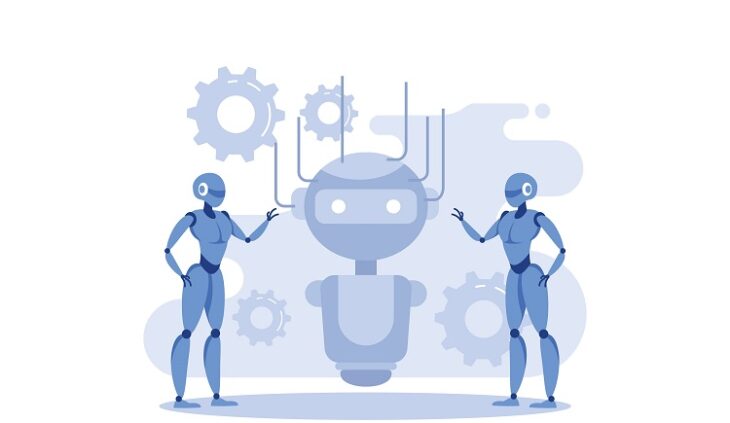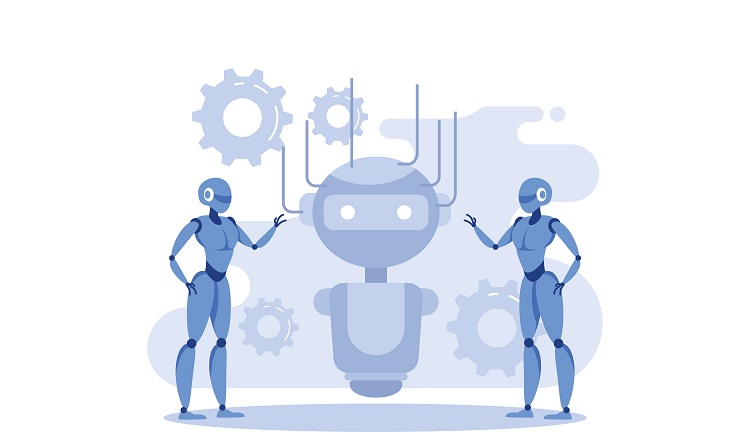Artificial intelligence stats and facts show just how much impact the AI market has had in the world. It has permanently shifted the technological landscape over the last few years.
However, the industry as a whole is still relatively new. As it continues to rise, AI and machine learning will drastically shape the way companies, businesses, and people interact with each other.
Here are a few facts and statistics that you should know.
Table of Contents
ToggleArtificial Intelligence Facts 2024
- AI can predict COVID-19 death statistics with a 92% accuracy.
- Google and Oxford Research recently released a deep learning AI system that can read lips better than 12.4% of the human brain (and with 4.8% accuracy).
- Netflix has saved over $1 billion by implementing machine learning through its personalized Netflix Recommendation Engine.
- The cashier-less Amazon Go stores made $4.5 billion in revenue in 2021, which is roughly 50% more compared to regular convenience stores.
- Animal welfare researcher Dr. Jean-Loup Rault predicted that people will have robotic pets in 2025.
- If AI were to be used in developing countries, it would have the potential to double the country’s economic growth by 2035.
- AI-enabled devices are everywhere. Nearly 77 percent of devices today use AI technology in one form or another.
Interesting & Surprising AI Stats and Facts 2024
- As one of the fastest-growing technologies in the world, AI is expected to have a market size of $270 billion by 2027.
- By 2030, it is expected to reach $15.7 trillion.
- 77% of people utilize a machine’s AI capabilities in one form or another, although only 33% are aware they are doing so.
- AI technology in the workplace has grown from 10% in 2015 to 37% in 2021.
- The use of AI increased drastically during the COVID-19 pandemic. AI Adoption grew 37% in the finance sector, 27% in the retail sector, and 20% in the IT sector.
- 83% of businesses say that developing and deploying an AI algorithm is crucial to their strategic priorities.
AI Adoption Across Industries Statistics
- AI is currently used the most for business analytics (33%), security (25%), and sales and marketing (16%). However, 40% of companies claim their biggest motivator for adopting the new technology is simplifying the customer experience.
- 54% of companies that use AI claim they’ve seen an increase in productivity. However, 80% of business leaders believe there is potential to increase productivity.
- 44% of businesses that have implemented AI technologies have also said they’ve seen a reduction in operating costs.
- AI can reduce call times by 70% in customer service industries resulting in a 40 to 60% cost saving.
- Implementing AI in a sales department can increase leads by more than 50%.
- 28% of companies use AI for marketing purposes. However, 84% of marketers believe that AI is more important than any other technology.
- The agricultural robotic industry is expected to reach $20.6 billion by 2025. $6.2 billion of that will be used on drones or UAVs (Unmanned Aerial Vehicles).
- AI usage in the education system is expected to be worth $6 billion by 2024.
- 80% of retail businesses believe they will use AI in one form or another by 2027.
- It is predicted that AI bots can handle most tasks and interactions with 90% accuracy in the banking industry.
- 51% of European manufacturers, 30% of Japanese manufacturers, and 28% of American manufacturers have incorporated AI into their business.
- US manufacturers that have deployed AI technologies reported a 12% increase in production.
Facts About Artificial Intelligence and Wearables
- The wearable AI market is expected to be worth $180 billion by 2025.
- The smartwatch wearable AI application alone is predicted to reach $96.31 billion by 2027, which is an increase of 19.6% compared to 2020.
- By 2025, the US will likely control the largest market share of wearable technologies (35%), followed by Latin America (20%).
- It is estimated that over 780 million units of smart wearable devices will be sold by the end of 2022.
- The AI technology used in the wearable itself has also evolved. In 2013, wearables had an average of 1.4 sensors. Nowadays, they have 4.1.
- Fitness wearables may also see a significant increase in AI usage. They are expected to generate $14.64 billion in revenue by 2027.
- 92.1% of industry leaders believe that 10% of the population will have smart clothing by 2025.
Artificial Intelligence and Autonomous Vehicles Statistics
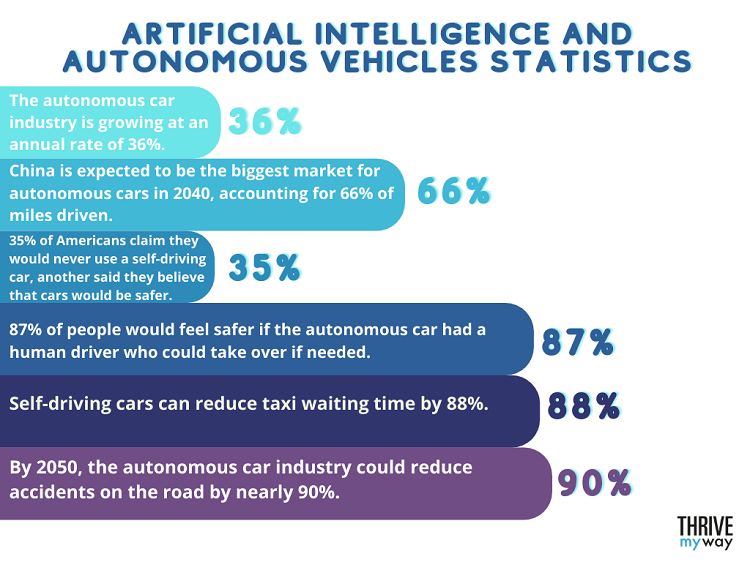
- There are currently 25 different countries developing self-driving cars.
- In 2021, the global autonomous car industry was worth over $54 billion.
- The autonomous car industry is growing at an annual rate of 36%. By 2030, there will likely be over 800,000 cars on the road.
- China is expected to be the biggest market for autonomous cars in 2040, accounting for 66% of miles driven.
- While 35% of Americans claim they would never use a self-driving car, another 67% said they believe self-driving cars would be safer compared to human drivers.
- 87% of people would feel safer if the autonomous car had a human driver who could take over if needed.
- Self-driving cars can reduce taxi waiting time by 88%.
- By 2050, the autonomous car industry could reduce accidents on the road by nearly 90%.
Facts about Artificial Intelligence and Robotics
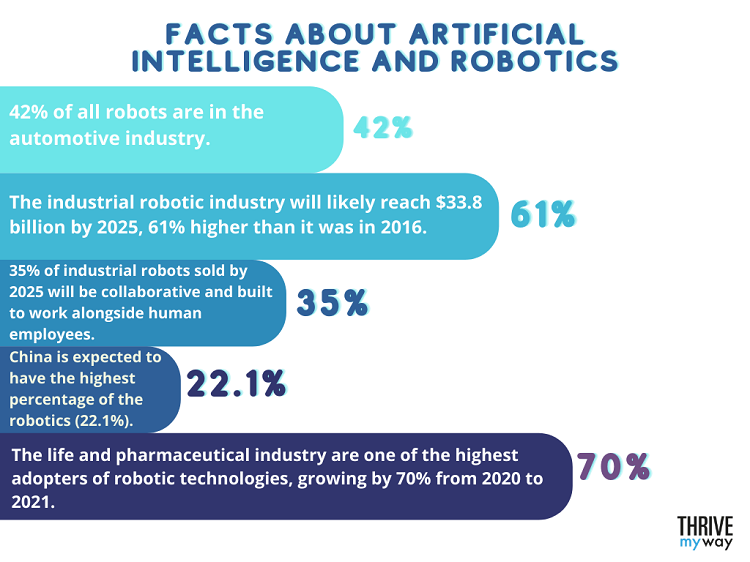
- There were 12 million robots in the world in 2020.
- 42% of all robots are in the automotive industry.
- The industrial robotic industry will likely reach $33.8 billion by 2025, 61% higher than it was in 2016.
- 35% of industrial robots sold by 2025 will be collaborative and built to work alongside human employees.
- China is expected to have the highest percentage of the robotic market share (22.1%), followed by the US (20.4%).
- The life and pharmaceutical industries are one of the highest adopters of robotic technologies, growing by 70% from 2020 to 2021.
- Amazon saves roughly $22 million every time they open a warehouse where they’ve implemented the Kiva collaborative robot.
Chatbots and Artificial Intelligence Facts
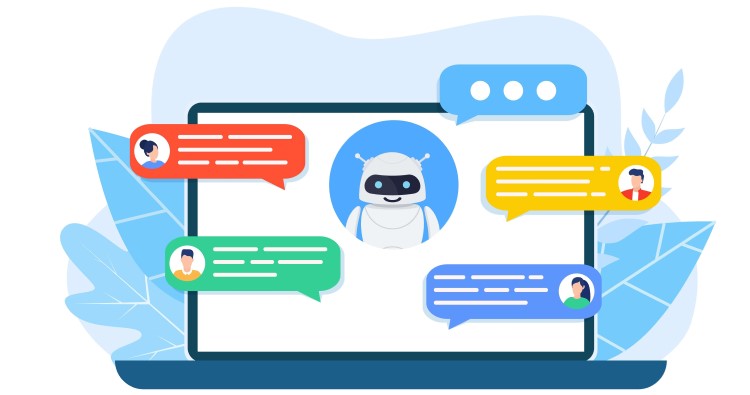
- It is expected that deep learning chatbots will have a 15% increase in usage in 2022 compared to 2018.
- Chatbots are expected to be used in 70% of customer interactions in 2022.
- 52% of telephone companies currently use chatbots for customer interactions.
- 27% of customers say they would prefer to talk with a humanoid robot rather than a real-life customer service representative.
- The three biggest benefits of using a chatbot system are 24-hour service (66%), instant responses (55%), and the ability to respond to simple questions (55%).
- Projections show that chatbots can save up to $8 billion globally a year.
Voice Search and Artificial Intelligence Statistics
- There are over 110 digital voice and virtual assistants in the US alone. Fifty-three million of those are Amazon Echo devices, which is 30% of the voice assistant marketplace. Google Assistant has 17% of the market share.
- 55% of customers say the biggest reason for using a speech recognition AI tool is to control their device hands-free.
- By 2024, there are expected to be 8.4 billion assistants being used on different devices, which is greater than the world’s total current population.
- With an accuracy of 98%, Google Assistant is the most accurate voice assistant. Amazon’s Alexa is 93%, while Apple’s Siri is only 68%.
- Only 54% of customers believe that a digital voice assistant is accurate in understanding their speech.
- With over 66,000 skills, Amazon’s Alexa has the most abilities out of any voice assistant.
Cyber Security with AI Statistics

- The AI cybersecurity industry will reach $46.3 billion by 2027, an impressive 23.6% growth from 2020.
- Every 39 seconds, there is a cyber data attack that takes place online, with roughly 300,000 pieces of malware being detected each day.
- In 2021, nearly 65% of companies worldwide were subject to a cyber data attack. Yet, only 12% of them had installed AI-based security analytics.
- 61% of businesses say it’s impossible to detect data security breaches without the help of artificial intelligence. 80% of those companies are telecom companies.
- AI-based cybersecurity for data is 15% more important for US businesses compared to any other country.
- 64% of companies believe that deploying AI-based cybersecurity will reduce the cost and time to detect potential threats in data.
- 52% of customers are skeptical about data privacy when using AI.
- Around 300 billion emails are sent each day. A machine learning algorithm has detected that the data in at least half of those were spam.
- With AI, plagiarized code in data can be detected with 87% accuracy.
Artificial Intelligence Statistics about Healthcare

- 38% of healthcare businesses use AI to help make a medical diagnosis.
- Over 100 different AI development devices were approved in 2020 for medical usage. The most common fields are radiology, cardiology, and hematology.
- The use of medical surgical robots was more than $4.6 billion in 2020. That number is likely to grow an additional 17.4% by 2027.
- Stanford University has developed a machine-learning algorithm that can predict the death of hospital patients with 90% accuracy.
- By 2027, healthcare is predicted to have the largest segment of intelligent machines for AI research and usage.
- It’s predicted that machines in healthcare that can perform without the assistance of a human will be 75% successful by 2022.
- AI has the potential to save the clinical healthcare industry more than $150 billion by 2026.
Impact of AI on Jobs and Employment Market Statistics
- It is expected that by 2025, 85 million jobs (or 16% of the US workforce) will be replaced by AI technologies.
- US workers have the highest risk of losing their job (38%), followed by German (35%) and British (30%) employees.
- Employees in administration, food preparation, construction, manufacturing, cleaning, and driving are most at risk of losing their jobs.
- On a positive note, AI could create up to 58 million more jobs in the US market, especially for data science engineers, content curators, and AI automation specialists.
- Currently, 150,000 people are working in engineering and assembly in different robotics and AI industries.
- Data Scientist positions on LinkedIn have increased by 650% from 2012 to 2021.
- 79% of company executives believe AI can simplify their workload and make their job more efficient in the long run.
AI Adoption Statistics
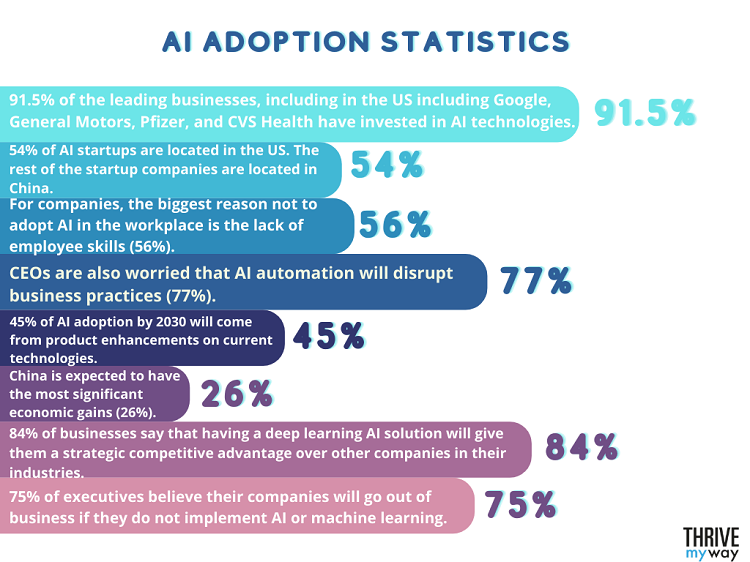
- 91.5% of the leading businesses, including in the US including Google, General Motors, Pfizer, and CVS Health have invested in AI technologies.
- 54% of AI startups are located in the US. 15% of startup companies are located in China.
- In 2018, the three most prominent Chinese AI investors were Chinese SenseTime ($ 1200 million), UBTech Robotics ($ 820 million), and Megvii Technology ($ 600 million).
- For companies, the biggest reason not to adopt AI in the workplace is the lack of employee skills (56%). This is followed by the fear of the unknown (42%) and the inability to find a starting point (26%).
- CEOs are also worried that AI automation will disrupt business practices (77%).
- 45% of AI adoption by 2030 will come from product enhancements on current technologies.
- In Q2 of 2019, startups received a total of $7.4 billion in AI investment and funding.
- China is expected to have the most significant economic gains from AI technologies, with an increased GDP of 26% by 2030. The US will likely come second.
- Facebook, Apple, Microsoft, Google, and Amazon acquired a total of 13 different AI startups in 2020 alone.
- 84% of businesses say that having a deep learning AI solution will give them a strategic competitive advantage over other companies in their industries.
- 75% of executives believe their companies will go out of business if they do not implement AI or machine learning.
You might be interested to check those related posts as well:
- 107 Amazing Machine Learning Stats 2024 [Trends & Facts You Need]
- 117 Cool Chatbot Statistics 2024 [Learn Digital Marketing]
- Top 3 and other Recommended Email Parsing Software for 2024
Regardless of whether you’re a company executive, a warehouse employee, or even just a smartphone owner, it’s easy to see the impact that artificial intelligence has on our daily lives. As this smart technology continues to develop, there’s no denying the long-lasting influence it will have on our world.
